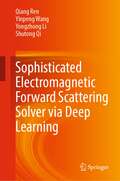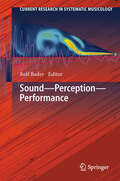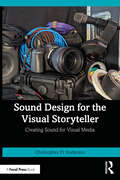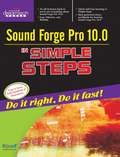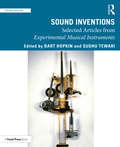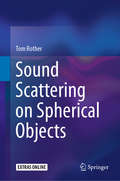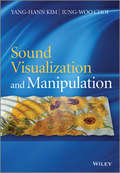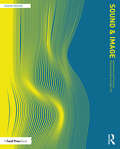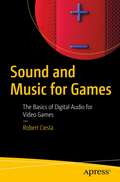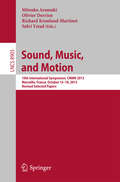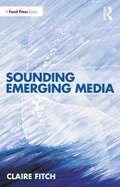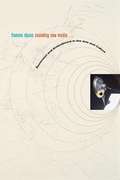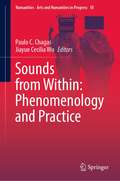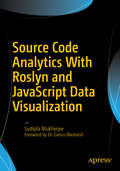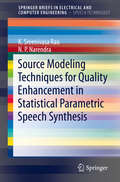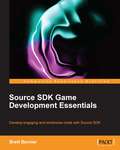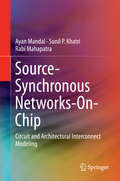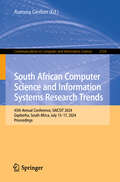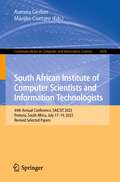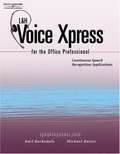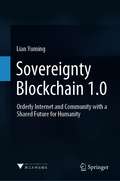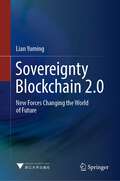- Table View
- List View
Sophie Loves Jimmy
by Nancy RuePaired with her classmate Jimmy for school and church projects, twelve-year-old Sophie must find a way to dispel the boyfriend rumors and to stop the cyberbullying campaign directed against her and a former school bad boy.
Sophisticated Electromagnetic Forward Scattering Solver via Deep Learning
by Qiang Ren Yinpeng Wang Yongzhong Li Shutong QiThis book investigates in detail the deep learning (DL) techniques in electromagnetic (EM) near-field scattering problems, assessing its potential to replace traditional numerical solvers in real-time forecast scenarios. Studies on EM scattering problems have attracted researchers in various fields, such as antenna design, geophysical exploration and remote sensing. Pursuing a holistic perspective, the book introduces the whole workflow in utilizing the DL framework to solve the scattering problems. To achieve precise approximation, medium-scale data sets are sufficient in training the proposed model. As a result, the fully trained framework can realize three orders of magnitude faster than the conventional FDFD solver. It is worth noting that the 2D and 3D scatterers in the scheme can be either lossless medium or metal, allowing the model to be more applicable. This book is intended for graduate students who are interested in deep learning with computational electromagnetics, professional practitioners working on EM scattering, or other corresponding researchers.
Sound - Perception - Performance
by Rolf BaderMusical Performance covers many aspects like Musical Acoustics, Music Psychology, or motor and prosodic actions. It deals with basic concepts of the origin or music and its evolution, ranges over neurocognitive foundations, and covers computational, technological, or simulation solutions. This volume gives an overview about current research in the foundation of musical performance studies on all these levels. Recent concepts of synchronized systems, evolutionary concepts, basic understanding of performance as Gestalt patterns, theories of chill as performance goals or historical aspects are covered. The neurocognitive basis of motor action in terms of music, musical syntax, as well as therapeutic aspects are discussed. State-of-the-art applications in performance realizations, like virtual room acoustics, virtual musicians, new concepts of real-time physical modeling using complex performance data as input or sensor and gesture studies with soft- and hardware solutions are presented. So although the field is still much larger, this volume presents current trends in terms of understanding, implementing, and perceiving performance.
Sound Design for the Visual Storyteller: Creating Sound for Visual Media
by Christopher D. AndersonSound Design for the Visual Storyteller is an overview of the sound design process for the beginner filmmaker or storyteller, providing the foundational knowledge needed to succeed at utilizing and designing sound for visual stories, films, and even podcasts.With a focus on television and film, alongside references to podcast, theatre, event, and game sound design, this all-in-one overview begins with the fundamentals of sound and the structure of a professional sound design team, before exploring the practical topics of post-production, creative workflows, and distribution. Supported by a plethora of audio and video examples to demonstrate key concepts, this book guides aspiring sound designers on the power and production value of the well-conceived soundtrack and showcases some of the most effective techniques for getting there.This is an ideal introduction for storytellers working in a range of contexts, including filmmakers, sound designers, and sound editors, as well as students of sound for film and broadcast.
Sound Forge Pro 10.0 In Simple Steps
by Kogent Learning Solutions IncSound Forge Pro 10.0 in Simple Steps helps you learn Sound Forge, a leading application developed by Sony for sound editing. Ample illustrations, easy to understand language, and precise information about the basic concepts of sound editing are few key points that make it stand apart from the rest of the books. The book is ideal for beginners looking for career opportunities in the domain of sound editing as well as professionals who are keen to upgrade their skills in this field.
Sound Inventions: Selected Articles from Experimental Musical Instruments (Sound Design)
by Bart Hopkin Sudhu TewariSound Inventions is a collection of 34 articles taken from Experimental Musical Instruments, the seminal journal published from 1984 through 1999. In addition to the selected articles, the editors have contributed introductory essays, placing the material in cultural and temporal context, providing an overview of the field both before and after the time of original publication. The Experimental Musical Instruments journal contributed extensively to a number of sub-fields, including sound sculpture and sound art, sound design, tuning theory, musical instrument acoustics, timbre and timbral perception, musical instrument construction and materials, pedagogy, and contemporary performance and composition. This book provides a picture of this important early period, presenting a wealth of material that is as valuable and relevant today as it was when first published, making it essential reading for anyone researching, working with or studying sound.
Sound Scattering on Spherical Objects
by Tom RotherThis book introduces readers to scattering from a practical/numerical point of view. The focus is on basic aspects like single scattering, multiple scattering, and whether inhomogeneous boundary conditions or inhomogeneous scatterers have to be taken into account. The powerful T-matrix approach is explained in detail and used throughout the book, and iterative solution methods are discussed. In addition, the book addresses appropriate criteria for estimating the accuracy of numerical results, as well as their importance for practical applications. Python code is provided with each chapter, and can be freely used and modified by readers. Moreover, numerous scattering results for different configurations are provided for benchmarking purposes. The book will be particularly valuable for those readers who plan to develop their own scattering code, and wish to test the correct numerical implementation of the underlying mathematics.
Sound Visualization and Manipulation
by Yang-Hann Kim Jung-Woo ChoiUnique in addressing two different problems – sound visualization and manipulation – in a unified way Advances in signal processing technology are enabling ever more accurate visualization of existing sound fields and precisely defined sound field production. The idea of explaining both the problem of sound visualization and the problem of the manipulation of sound within one book supports this inter-related area of study. With rapid development of array technologies, it is possible to do much in terms of visualization and manipulation, among other technologies involved with the spatial distribution of sound. This book aims to explore various basic functions for the visualization and manipulation and demonstrate to the reader how these properties determine the quality of visualization and manipulation. The first half of the book introduces some basic and general concepts and theories and the second part of the book explains a number of techniques in sound visualization and manipulation. It offers a unified presentation to two very different topics - sound field visualization techniques based on microphone arrays, and techniques for generation of controlled sound fields using loudspeaker arrays. The authors emphasize the similarities between these two physical problems and between the mathematical methods used for solving them. With extensive examples throughout the book, chapters include: Acoustic Wave Equation and its Basic Physical Measures, Acoustic Wave Equation and its Basic Physical Measures, Basic Theory of Sound Visualization, Acoustic Holography, Beamforming, Basic Theory of Sound Manipulation, Sound Focusing, and Sound Field Reproduction. The first book to combine both the visualization and manipulation of sound technologies in one comprehensive volume Presents the basic concepts using simple one dimensional cases and then extends the concept to three dimensional cases, enabling easier understanding of the fundamental concepts through the use of minimum mathematics Provides a solid understanding of associated physics as well as mathematical concepts for understanding the technologies, addressing diffraction problems in an integrated format by using Kirchhoff-Helmholtz integral equation Uses extensive examples demonstrating the benefits and drawbacks of various applications, including beamforming and acoustic holography A valuable resource forpost/graduate students, acoustic engineers, audio and noise control system developers
Sound and Image: Aesthetics and Practices (Sound Design)
by Andrew Knight-HillSound and Image: Aesthetics and Practices brings together international artist scholars to explore diverse sound and image practices, applying critical perspectives to interrogate and evaluate both the aesthetics and practices that underpin the audiovisual. Contributions draw upon established discourses in electroacoustic music, media art history, film studies, critical theory and dance; framing and critiquing these arguments within the context of diverse audiovisual practices. The volume’s interdisciplinary perspective contributes to the rich and evolving dialogue surrounding the audiovisual, demonstrating the value and significance of practice-informed theory, and theory derived from practice. The ideas and approaches explored within this book will find application in a wide range of contexts across the whole scope of audiovisuality, from visual music and experimental film, to narrative film and documentary, to live performance, sound design and into sonic art and electroacoustic music. This book is ideal for artists, composers and researchers investigating theoretical positions and compositional practices which bring together sound and image.
Sound and Music for Games: The Basics of Digital Audio for Video Games
by Robert CieslaGrasp the fundamentals of digital audio work in the context of video games, including the basics of middleware such as Fmod and Wwise. We will review software such as Apple's Logic and Garageband, Paul Davis's Ardour, and many other popular digital audio workstations. We will start with an introduction to the basic terminology of digital audio work while also getting acquainted with current generation audio hardware. We will then discuss the basics of the venerable Musical Instrument Digital Interface (MIDI) and how it relates to music composition as well as the tools and techniques for writing tracker music/chiptunes. The book also covers plug-in software, soundproofing at home, and voice work. The book takes a practical approach while tackling both hardware and software components used in cutting edge audio engineering, composition, and audio monitoring. What You Will Learn • Understand the fundamentals of digital audio production in the context of video games • Learn about audio integration with popular middleware solutions and APIs • Leverage plugin effects software to sculpt your audio to professional levels • Identify modern audio file formats and how and when to use them • Learn best practices when mixing sound effects and music for video games Who Is This Book For The intended readership includes beginners in digital audio engineering who use Windows, macOS, or Linux.
Sound, Music, and Motion
by Mitsuko Aramaki Olivier Derrien Richard Kronland-Martinet Sølvi YstadThis book constitutes the thoroughly refereed post-conference proceedings of the 10th International Symposium on Computer Music Modeling and Retrieval, CMMR 2013, held in Marseille, France, in October 2013. The 38 conference papers presented were carefully reviewed and selected from 94 submissions. The chapters reflect the interdisciplinary nature of this conference with following topics: augmented musical instruments and gesture recognition, music and emotions: representation, recognition, and audience/performers studies, the art of sonification, when auditory cues shape human sensorimotor performance, music and sound data mining, interactive sound synthesis, non-stationarity, dynamics and mathematical modeling, image-sound interaction, auditory perception and cognitive inspiration, and modeling of sound and music computational musicology.
Sounding Emerging Media
by Claire FitchSounding Emerging Media details a practice-based approach to sonic art and electroacoustic composition, drawing on methodologies inspired by the production of electronic literature, and game development. Using the structural concepts identified by Gilles Deleuze and Félix Guattari, the book is based around ideas related to labels such as Assemblage, Strata, Smooth and Striated Space, Temporal Space and, The Fold. The processes employed to undertake this research involved the creation of original texts, the development of frameworks for improvisation, the use of recordings within the process and implementation of techniques drawn from the practices of electroacoustic composition, and the use of ideas borrowed from electronic literature, publishing and game development. The results have helped to shape a compositional style which draws on these processes individually or collectively, drawing on practice often seen in game development, visual scores and composition using techniques found in electroacoustic music. Providing a journey through the landscape of emerging digital media, Sounding Emerging Media envisages a world where the composer/user/listener all become part of a continuum of collective artistry. This book is the ideal guide to the history and creation of audio for innovative digital media formats and represents crucial reading for both students and practitioners, from aspiring composers to experienced professionals.
Sounding New Media: Immersion and Embodiment in the Arts and Culture
by Frances DysonThe concept of embodiment, as either a site of resistance to technological incorporation, or a site of excess toward which technology will always aim but never arrive, is no longer adequate to represent the realities of technoculture.
Sounds from Within: Phenomenology and Practice (Numanities - Arts and Humanities in Progress #18)
by Paulo C. Chagas Jiayue Cecilia WuThis book transforms phenomenology, music, technology, and the cultural arts from within. Gathering contributions by performing artists, media technology designers, nomadic composers, and distinguished musicological scholars, it explores a rich array of concepts such as embodiment, art and technology, mindfulness meditation, time and space in music, self and emptiness, as well as cultural heritage preservation. It does so via close studies on music phenomenology theory, works involving experimental music and technology, and related cultural and historical issues. This book will be of considerable interest to readers from the fields of sound studies, science and technology studies, phenomenology, cultural studies, media studies, and sound art theory. This book is equally relevant and insightful for musicians, composers, media artists, sound artists, technology designers, and curators and arts administrators from the performing and visual arts.
Source Code Analytics With Roslyn and JavaScript Data Visualization
by Sudipta MukherjeeLearn how to build an interactive source code analytics system using Roslyn and JavaScript. This concise 150 page book will help you create and use practical code analysis tools utilizing the new features of Microsoft's Roslyn compiler to understand the health of your code and identify parts of the code for refactoring. Source code is one of the biggest assets of a software company. However if not maintained well, it can become a big liability. As source code becomes larger. more complex and accessed via the cloud, maintaining code quality becomes even more challenging. The author provides straightforward tools and advice on how to manage code quality in this new environment. Roslyn exposes a set of APIs which allow developers to parse their C# and VB. NET code and drastically lower the barrier to entry for Meta programming in . NET. Roslyn has a dedicated set of APIs for creating custom refactoring for integrating with Visual Studio. This title will show readers how to use Roslyn along with industry standard JavaScript visualization APIs like HighCharts, D3. js etc to create a scalable and highly responsive source code analytics system. What You Will Learn Understand the Roslyn Syntax API Use Data Visualization techniques to assist code analysis process visually Code health monitoring matrices (from the standard of Code Query Language) Code mining techniques to identify design patterns used in source code Code forensics techniques to identify probable author of a given source code Techniques to identify duplicate/near duplicate code Who This Book is For . NET Software Developers and Architects
Source Modeling Techniques for Quality Enhancement in Statistical Parametric Speech Synthesis (SpringerBriefs in Speech Technology)
by K. Sreenivasa Rao N. P. NarendraThis book presents a statistical parametric speech synthesis (SPSS) framework for developing a speech synthesis system where the desired speech is generated from the parameters of vocal tract and excitation source. Throughout the book, the authors discuss novel source modeling techniques to enhance the naturalness and overall intelligibility of the SPSS system. This book provides several important methods and models for generating the excitation source parameters for enhancing the overall quality of synthesized speech. The contents of the book are useful for both researchers and system developers. For researchers, the book is useful for knowing the current state-of-the-art excitation source models for SPSS and further refining the source models to incorporate the realistic semantics present in the text. For system developers, the book is useful to integrate the sophisticated excitation source models mentioned to the latest models of mobile/smart phones.
Source SDK Game Development Essentials
by Brett BernierThis book is written by a gamer, for a gamer to guide just about anything with Source SDK giving a firm grasp of all the tools it has to offer using step-by-step explanations. If you're a keen gamer who wants a bit more out of your favorite game and create your own modifications (mods) and levels with the Source engine, this book is great for you. No programming and Source SDK experience is required.
Source-Synchronous Networks-On-Chip
by Sunil P. Khatri Ayan Mandal Rabi MahapatraThis book describes novel methods for network-on-chip (NoC) design, using source-synchronous high-speed resonant clocks. The authors discuss NoCs from the bottom up, providing circuit level details, before providing architectural simulations. As a result, readers will get a complete picture of how a NoC can be designed and optimized. Using the methods described in this book, readers are enabled to design NoCs that are 5X better than existing approaches in terms of latency and throughput and can also sustain a significantly greater amount of traffic.
South African Computer Science and Information Systems Research Trends: 45th Annual Conference, SAICSIT 2024, Gqeberha, South Africa, July 15–17, 2024, Proceedings (Communications in Computer and Information Science #2159)
by Aurona GerberThis book contains a selection of the best papers of the 45th Annual Conference, SAICSIT 2024, held in Gqeberha, South Africa, in July 2024. The 26 full papers included in this book were carefully reviewed and selected from 81 submissions. They focus on the transforming relationship between humans and machines. This year's theme is "Human-Machine-Digital-Convergence".
South African Institute of Computer Scientists and Information Technologists: 44th Annual Conference, SAICSIT 2023, Pretoria, South Africa, July 17–19, 2023, Revised Selected Papers (Communications in Computer and Information Science #1878)
by Marijke Coetzee Aurona GerberThis book contains a selection of the best papers of the 44th Annual Conference, SAICSIT 2023, held in Pretoria, South Africa, in July 2023.The 18 papers presented in this volume were carefully reviewed and selected from 54 regular submissions. They adress various aspects of the role of computer science in connectivity, information systems for connectivity, connecting society and emerging technologies for connectivity
South Western L and H VoiceXpress for the Office Professional
by Karl Barksdale Michael RutterVoice typing is transforming the way people work, write, and enter data. With Voice X Press for the Office Professional, your students can learn the most effective way to use this new software and be able to apply it to the various office applications. This book takes students step-by-step through the speech learning process, providing tips and advice along the way.
South-Western L and H VoiceXpress QuickTorial
by Karl Barksdale Michael Rutter J. Alan BaumgartenThis book contains step-by-step activities that help users master the techniques and extra reinforcement activities that provide enrichment opportunities. Appendices on using the software with Word and WordPerfect are included. Natural language commands are emphasized throughout the text.
Sovereignty Blockchain 1.0: Orderly Internet and Community with a Shared Future for Humanity
by Lian YumingThis book presents a general framework analysis of sovereignty in blockchain based on the concept of blockchain technology, and specifically discusses the three theoretical foundations of sovereignty in blockchain: data sovereignty theory, social trust theory, and smart contract theory. It also explores the evolution of laws concerning data and digital rights, how to build trust mechanisms for digital rights transactions, as well as contract signing and the implementation of digital rights transactions.
Sovereignty Blockchain 2.0: New Forces Changing the World of Future
by Lian YumingThis book is a continuation and deepening of Sovereign Blockchain 1.0. It mainly includes three views: 1) Blockchain is a super public product based on digital civilization. 2) The Internet is an advanced level of industrial civilization, the core of which is connection; blockchain is an important symbol of digital civilization, the essence of which is reconstruction. 3) Digital currency will trigger a comprehensive change in the economic field, and digital identity will reconstruct the governance model in the social field, thereby changing the order of civilization.This book is not only a popular science book based on blockchain thinking, theory and application research, but also a scholarly work on the technical and philosophical issues of governance and the future. By reading Sovereign Blockchain 2.0, policymakers can quickly understand the basic knowledge and frontier dynamics of science and technology; science and technology workers can grasp the general trend, seize opportunities, face problems and difficulties, aim at the world's science and technology frontier and lead the direction of science and technology development; experts and scholars in law and legal fields can see new ideas, concepts and models of data governance; social science researchers can discover data sociology and data philosophy issues.
Soziale Medien: Interdisziplinäre Zugänge zur Onlinekommunikation (ars digitalis)
by Peter Klimczak Christer Petersen Samuel BreidenbachBildeten noch vor wenigen Jahren Presse, Rundfunk und Fernsehen den primären Zugang der Gesellschaft zu sich selbst, sind heutige gesellschaftliche Debatten sowie das Phänomen der Öffentlichkeit in hohem Maße durch den Einfluss von Social Media geprägt. Das Neue der dortigen Kommunikation ist, dass sie durch algorithmische Selektionen vorgeformt wird, in hohem Maße personalisiert ist und Beiträge automatisierter Accounts enthalten kann. Diese Charakteristika stellen die Forschung in der Einordnung und Bewertung des gesellschaftlichen Einflusses von Social Media-Debatten immer noch vor Schwierigkeiten und verlangen nach transdisziplinären Ansätzen. Beiträge aus der Informatik und den Computational Humanities ergänzen deshalb die medien- und kommunikationswissenschaftlichen Perspektiven jeweils um eine Beschreibung der technischen Grundlagen ihrer Untersuchungsgegenstände und der möglichen Zugänge zum Objektbereich.

